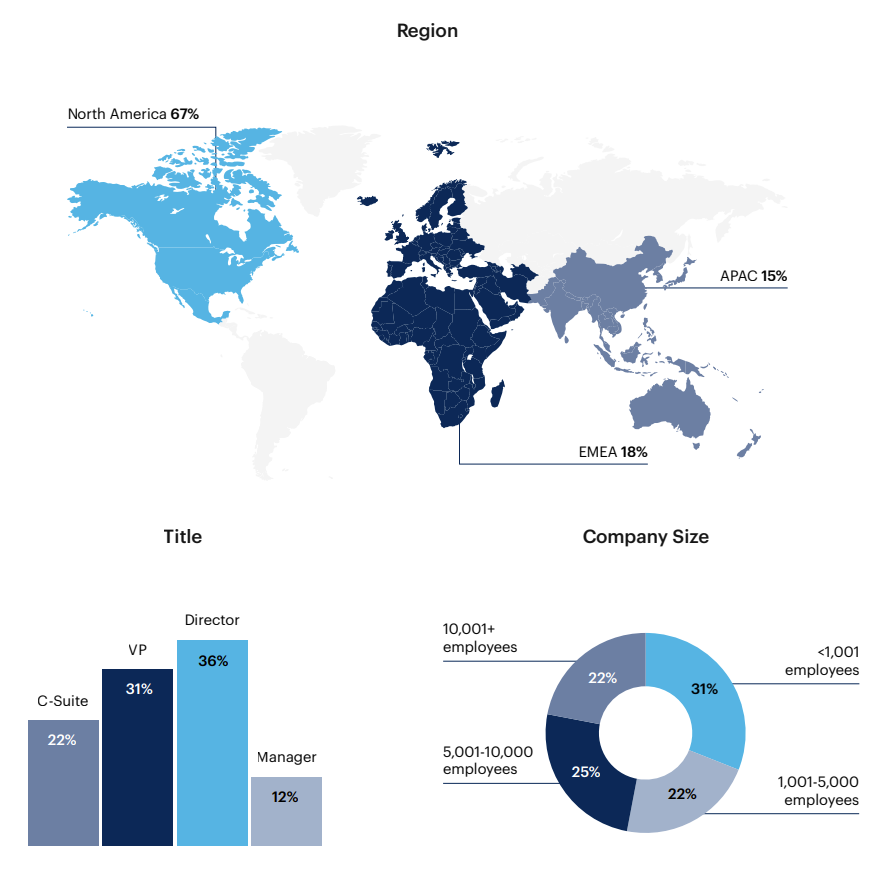Hybrid Infrastructure
Hybrid infrastructure: Adoption, deployment, and future investment
Hybrid infrastructure is an IT environment that mixes on-premises and cloud IT infrastructure. What benefits and use cases are driving organizations' investments in hybrid infrastructure?
One minute insights:
 Over half of respondents have adopted hybrid infrastructure in response to newer technology requirements and/or business continuity
Over half of respondents have adopted hybrid infrastructure in response to newer technology requirements and/or business continuity  Leaders reported investing more in cloud than on-premises infrastructure, specifically public cloud
Leaders reported investing more in cloud than on-premises infrastructure, specifically public cloud Most organizations are conducting assessments of their infrastructure for updates and additional investments at least annually
Most organizations are conducting assessments of their infrastructure for updates and additional investments at least annually Edge computing will have the most impact on an organization's future hybrid infrastructure investments
Edge computing will have the most impact on an organization's future hybrid infrastructure investments Scalability, control over systems customization, and remote work enablement were ranked the top benefits of hybrid infrastructure
Scalability, control over systems customization, and remote work enablement were ranked the top benefits of hybrid infrastructure
Organizations are investing in hybrid infrastructure to meet the demands of newer technology and a hybrid workforce
Over half of respondents (56%) reported their organization adopted hybrid infrastructure because it was required for new technologies. Additionally, 54% of respondents reported that business continuity contributed to their organization’s decision to adopt hybrid infrastructure.
What contributed to your organization’s decision to adopt hybrid infrastructure?

Improving security 34%, Future-proofing the organization 30%, Business geographic expansion 27%, Driving process maturity 14%, New I/O leadership 4%, Other 1%, None of these 1%
Only 23% of respondents said hybrid remote work had not impacted their organization’s investments in hybrid infrastructure. 42% said their investments had increased, while 34% said investments had decreased.
Has continued hybrid remote work impacted your organization’s investment in hybrid infrastructure over the last year?
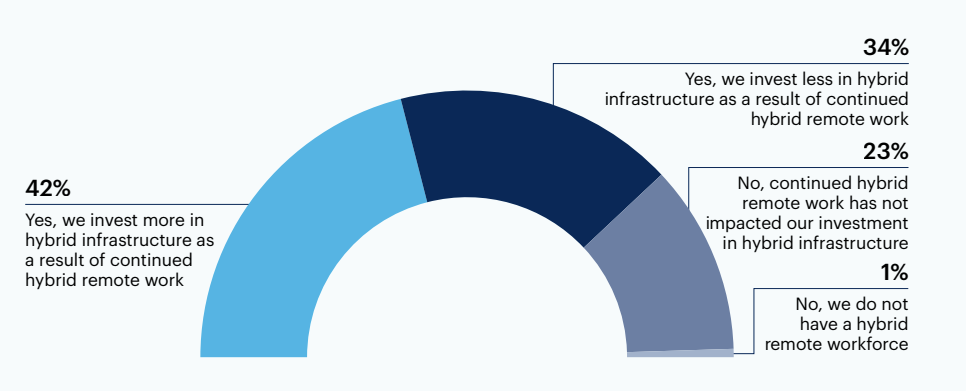
Unsure 0%
n = 200
As for difficulties implementing hybrid infrastructure within their organization, most respondents have faced increased complexity of enterprise architecture (59%), technology compatibility issues (50%) or lack of readiness for data migration (44%).
What difficulties have you faced with implementing a hybrid infrastructure at your organization?
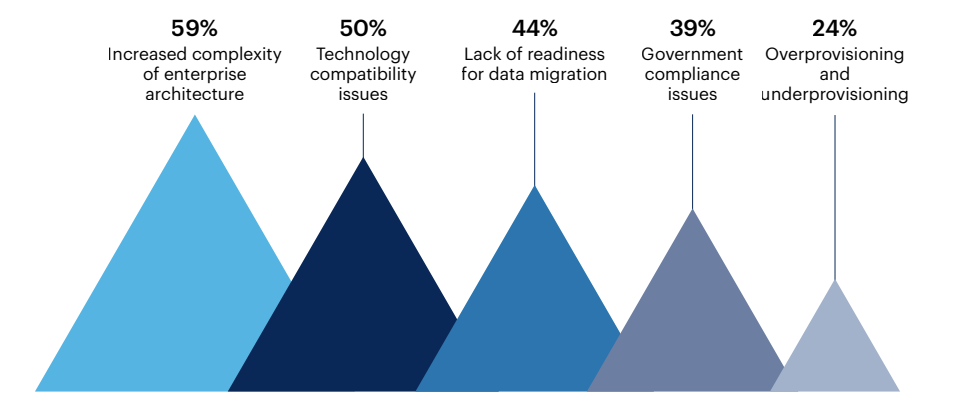
Poorly defined SLAs 24%, Lack of redundancy 23%, Data security in-transit/at rest 19%, Shadow IT 16%, Talent gaps (e.g., lack of experienced cloud engineers) 13%, Lack of uniform security strategy (e.g., on-prem vs cloud; individual apps etc.) 10%, Lack of time to implement 7%, Lack of employee buy-in 6%, Executive resistance 3%, None of these 1%, Other 0%
n = 200
Respondents ranked scalability, control over systems customization, and remote work enablement as the top three benefits of hybrid infrastructure.
Please rank the top three benefits of hybrid infrastructure in order of impact on your organization, with the most impactful on top:
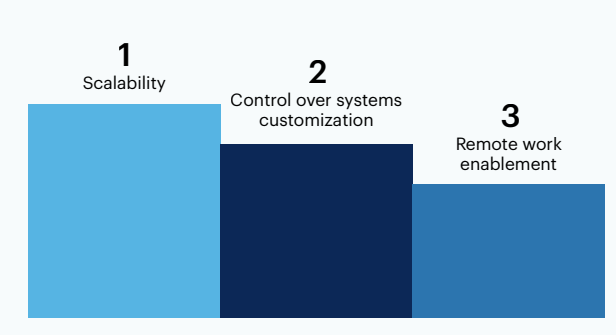
Improved process efficiency, Cost savings, Business continuity, Improved enterprise architecture, Improved agility, Improved innovation, Data management, AI integration
n = 200
Hybrid infrastructure is a journey towards going totally into [the] cloud!
[Hybrid infrastructure] is a must for large enterprise organizations as everything cannot be done on-premises or in cloud.
Organizations are regularly assessing their hybrid infrastructure for additional investment opportunities — and most are investing in public cloud infrastructure
The majority of respondents (94%) said their organization assesses their hybrid infrastructure at least once per year for additional investment and update opportunities
How often does your organization assess your hybrid infrastructure for additional investments and update opportunities?

51% of respondents reported investing more towards cloud infrastructure in the last year, while 33.5% said they invested more in on-premises infrastructure. 14% of respondents reported investing equally across both.
In the last year, have you invested more heavily in on-premises or cloud infrastructure?
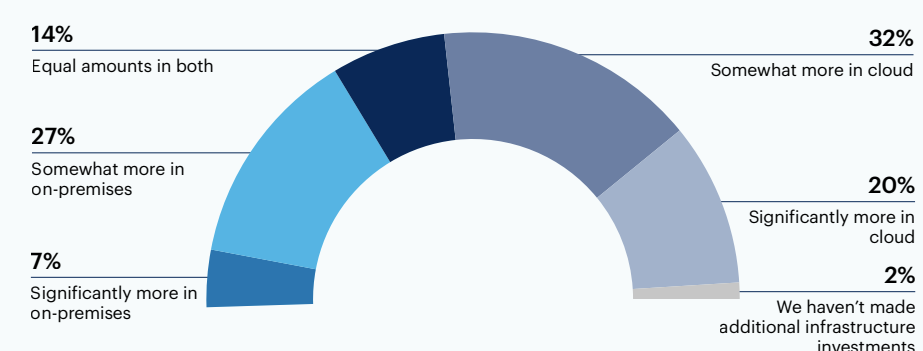
Unsure 0%
n = 200
Meanwhile, when comparing public cloud vs private cloud investments, 47% of respondents said they’re investing more in public cloud, 39% are investing more in private cloud, and 22% are investing equally across both.
In the last year, have you invested more heavily in public cloud or private cloud?
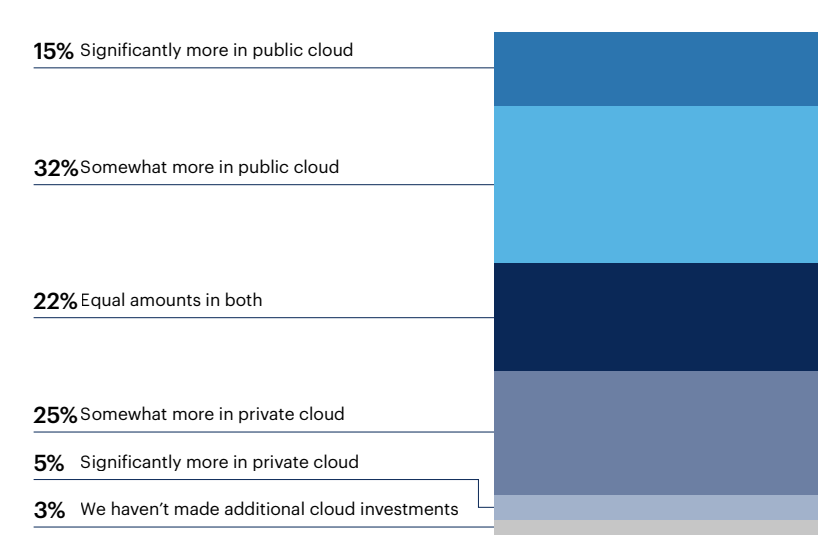
Unsure 0%
n = 200
Respondents identified edge computing (48%), data classification/management systems (38%) and storage as a service (37%) as emerging technologies that are most likely to impact their organization's future hybrid infrastructure investments.
Which of the following technologies are most likely to impact your organization’s future hybrid infrastructure investments?
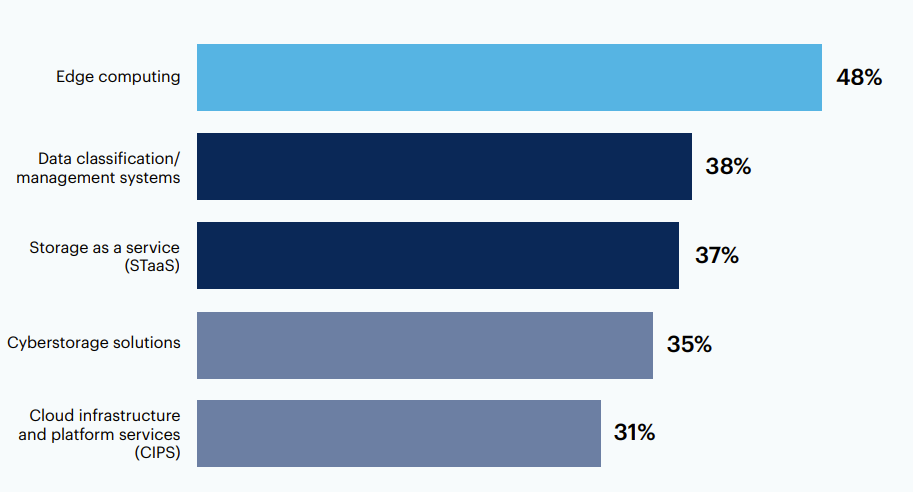
Internet of things (IoT) 28%, Backup as a service (BaaS) 20%, AIOps storage management 18%, Enterprise resource planning (ERP) systems 13%, Big data analytics 13%, Software defined storage (SDS) 10%, Customer relationship management (CRM) systems 9%, Data processing units (DPUs) 8%, Predictive analysis 7%, Blockchain 6%, Storage processing units (SPUs) 5%, None of these 1%, Other 0%
n = 288
Being hybrid is truly a necessity as we are moving more and more to the public cloud with our infrastructure and applications. We keep our most valuable IT and development on-premises for a more secure environment, but I envision that will change over time.
Hybrid Infrastructure is the best option for enterprises as they can have a balance of security, performance and scalability.

Want more insights like this from leaders like yourself?
Click here to explore the revamped, retooled and reimagined Gartner Peer Community. You'll get access to synthesized insights and engaging discussions from a community of your peers.
Respondent Breakdown
